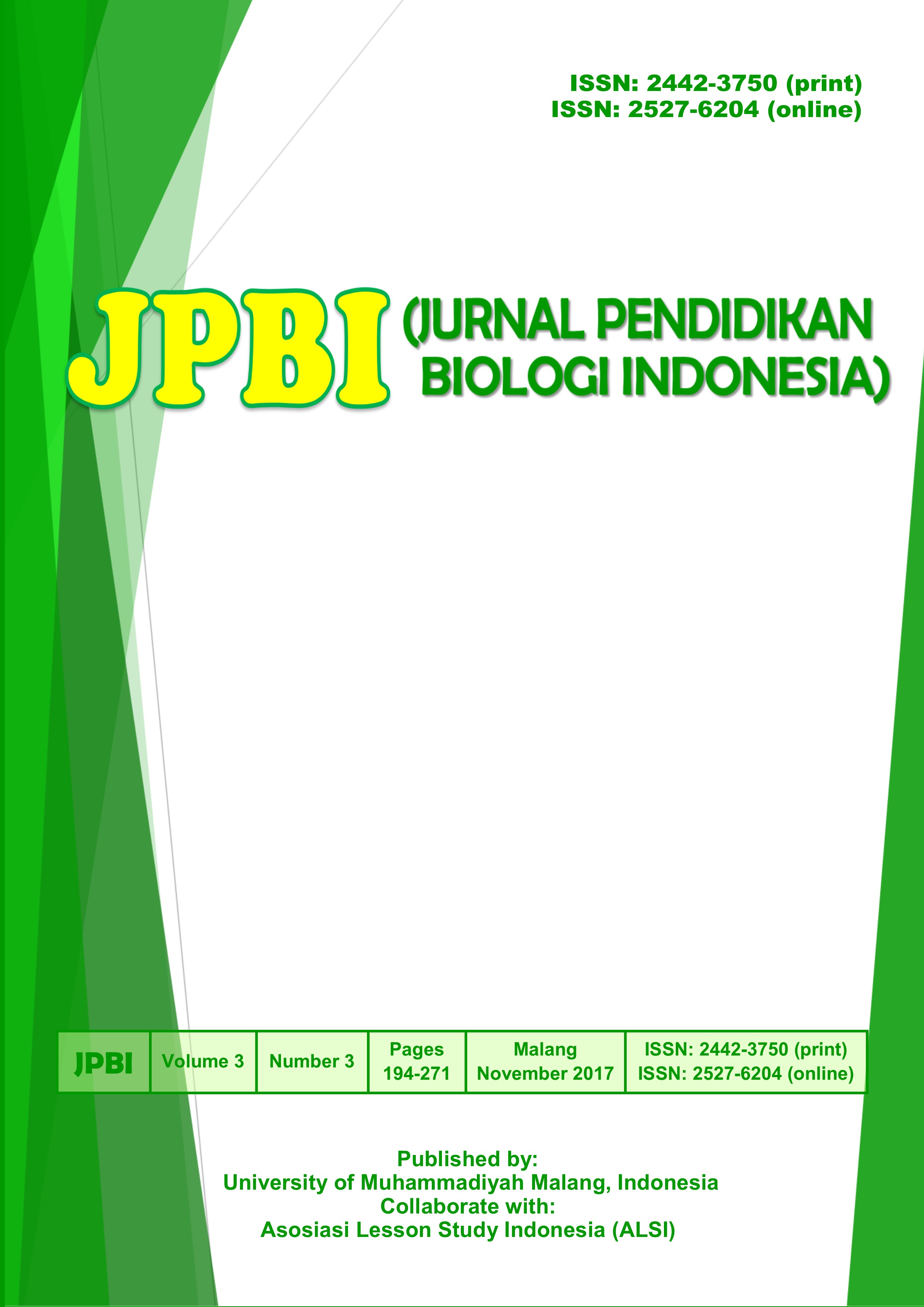Improving of scientific literacy ability using discovery learning model at the seventh grade students of state JHS 3 Ngronggot, Nganjuk-Indonesia
DOI:
https://doi.org/10.22219/jpbi.v3i3.4597Keywords:
Discovery learning, junior high school, scientific literacy, skill, studentAbstract
Country with good education condition can be seen through its citizen scientific literacy. This research aims to improving the students’ scientific literacy ability by using discovery learning model at 7th grade students of State Junior High School 3 Ngronggot, Nganjuk-Indonesia. The instrument in this Kemmis and Taggart Model of Classroom Action Research was an essay test composed based on indicators developed by Gormaly. The results of the research showed that there were improvements on the students’ scientific literacy ability from cycle I to cycle II on six of seven indicators. Those improvements are as follows: Indentifying scientific opinion increased from 0% into 64.52%, reviewing literature effectively increased from 0% into 29.03%, understanding research design and the way how its effect to the finding/discussion increased from 14.29% into 19.35%, making graphic from the data correctly increased from 0% to 58.07%, solving problems using quantitative skill including operating basic statistics increased from 7.14% to 58.07%. However, in making inference, prediction and drawing conclusion based on quantitative data, the improvement was only on the students’ answer that got 1 score, it increased from 7.14% to 77.42%. In addition, for the indicator of understanding and interpreting basic statistic, it decreased from 21.43% to 12.90%.Downloads
References
Astuti, Y. K. (2016). Science literation in learning IPA. Gema Wiralodra. 7(3b), 67-72.
Borthick, A. F. & Jones, D. R. (2000). Motivation for collaborative online learning invention and its application in information systems security course. Issues in Accounting Education, 15(2), 181-210.
Budiningsih, C. A. (2005). Belajar dan pembelajaran. Jakarta: Rineka Cipta.
Cahyo, A. N. (2013). Panduan aplikasi teori-teori belajar mengajar teraktual dan terpopuler. Jogjakarta: Diva Press.
Cobble, S. (2012). Encouraging environmental literacy on campus. Professional Paper Requirement for Hawaii Pacific University’s College of Humanities and Social Sciences. Retrieved from http://www.kukuicup/org/ vision.
Gormally, C., Brickman, P., Hallar, B. & Armstrong, N. (2009). Effects of inquiry-based learning on students’ science literacy skills and confidence. International Journal for the Scholarship of Teaching and Learning, 3(2,) Available at: https://doi.org/10.20429/ijsotl.2009.030216.
Gormally, C., Brigman, P. & Lutz, M. (2012). Developing a test of scientific literacy skills (TOSLS): Measuring undergraduates’ evaluation of scientific information and arguments. CBE-Life Sciences Education, 11, 364-377.
Holbrook, J. (2005). Making chemistry teaching relevant. Chemical Education International, 6(1), 1-12.
Istikomayanti, Y., Suwono, H., & Irawati, M.H., (2016). Experential learning group investigation as effort to developt environmental literacy ability at 5th Grade Students of Madrasah Ibtidaiyah. Jurnal Pendidikan Biologi Indonesia, 2(1), 57-71.
Iswari, Y. D. 2011. Problem solving problem-based laboratory activities on soluble matter and solubility times to improve student's science literacy (Unpublished Thesis). Bandung: SPS UPI.
Laugksch, R. C. (2000). Scientific literacy: A conceptual overview. Sci. Ed, 84, 71-94.
National Research Council. 1996. National Science Education Standart. Retrived from:http://www.nap.edu/catalog/4962.html.
OECD. (2006). Assesing scientific, reading and mathematical literacy (A framework for PISA 2006). Retrieved from http://www. oecd.org/edu/school/assessingscientificreadingandmathematicalliteracyaframeworkforpisa2006.htm.
OECD. (2014). PISA 2012 Results in focus: What 15-year-olds know and what they can do with what they know. Paris: OECD.
Rakhmawan, A., Setiabudi, A., Mudzakir, A., (2015). Design of learning sciense literacy based inquiry on laboratory activities. Jurnal Penelitian dan Pembelajaran IPA, 1(1), 143-152.
Rusilowati, A., Sunyoto, E. N., & Mulyani, S. (2015). Developing of science textbook based on scientific literacy for seventh grade of secondary school. Proceeding of International Conference on Mathematics, Science, and Education (ICMSE). Retrieved from http://icmseunnes.com/2015/wp-con-tent/ uploads/2016/03/89_ SE.pdf.
Turiman, P., Omar, J., Daud, M. A., & Osman, K. (2012). Fostering the 21st century skills through scientific literacy and science process skills. Procedia, Social and Behavioral Sciences, 59, 110-116
Wenning, C.J. 2011. Experimental inquiry in introductory physics courses. Journal Physics Teacher Education Online, 6(2), 2-8.
Widayati, A. (2008). Penelitian tindakan kelas. Jurnal Pendidikan Akuntansi Indonesia, 6(1), 87-93.
Downloads
Published
Issue
Section
License
Authors who publish with JPBI (Jurnal Pendidikan Biologi Indonesia) agree to the following terms:
- For all articles published in JPBI, copyright is retained by the authors. Authors give permission to the publisher to announce the work with conditions. When the manuscript is accepted for publication, the authors agree to automatic transfer of the publishing right to the publisher.
- Authors retain copyright and grant the journal right of first publication with the work simultaneously licensed under a Creative Commons Attribution-ShareAlike 4.0 International License that allows others to share the work with an acknowledgment of the work's authorship and initial publication in this journal.
- Authors are able to enter into separate, additional contractual arrangements for the non-exclusive distribution of the journal's published version of the work (e.g., post it to an institutional repository or publish it in a book), with an acknowledgment of its initial publication in this journal.
- Authors are permitted and encouraged to post their work online (e.g., in institutional repositories or on their website) prior to and during the submission process, as it can lead to productive exchanges, as well as earlier and greater citation of published work (See The Effect of Open Access).

This work is licensed under a Creative Commons Attribution-ShareAlike 4.0 International License.


















